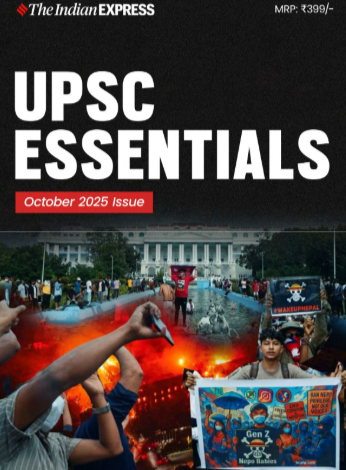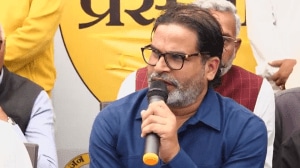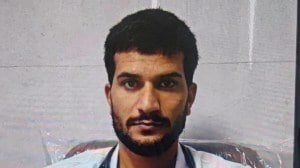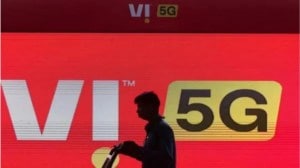Priya Kumari Shukla is a Senior Copy Editor in the Indian Express (digital). She contributes to the UPSC Section of Indian Express (digital) and started niche initiatives such as UPSC Key, UPSC Ethics Simplified, and The 360° UPSC Debate. The UPSC Key aims to assist students and aspirants in their preparation for the Civil Services and other competitive examinations. It provides valuable guidance on effective strategies for reading and comprehending newspaper content. The 360° UPSC Debate tackles a topic from all perspectives after sorting through various publications. The chosen framework for the discussion is structured in a manner that encompasses both the arguments in favour and against the topic, ensuring comprehensive coverage of many perspectives. Prior to her involvement with the Indian Express, she had affiliations with a non-governmental organisation (NGO) as well as several coaching and edutech enterprises. In her prior professional experience, she was responsible for creating and refining material in various domains, including article composition and voiceover video production. She has written in-house books on many subjects, including modern India, ancient Indian history, internal security, international relations, and the Indian economy. She has more than eight years of expertise in the field of content writing. Priya holds a Master's degree in Electronic Science from the University of Pune as well as an Executive Programme in Public Policy and Management (EPPPM) from the esteemed Indian Institute of Management Calcutta, widely recognised as one of the most prestigious business schools in India. She is also an alumni of Jamia Milia Islamia University Residential Coaching Academy (RCA). Priya has made diligent efforts to engage in research endeavours, acquiring the necessary skills to effectively examine and synthesise facts and empirical evidence prior to presenting their perspective. Priya demonstrates a strong passion for reading, particularly in the genres of classical Hindi, English, Maithili, and Marathi novels and novellas. Additionally, she possessed the distinction of being a cricket player at the national level. Qualification, Degrees / other achievements: Master's degree in Electronic Science from University of Pune and Executive Programme in Public Policy and Management (EPPPM) from Indian Institute of Management Calcutta ... Read More
UPSC Key—4th December, 2023: Coal phase-out, Cyclone Michaung and All India Judicial Service
Exclusive for Subscribers from Monday to Friday: Why “phase-out” of coal to “phase-down” of Coal and India’s stand on renewable energy are relevant to the UPSC Exam? What significance do topics like Indian military personnel in Maldives, Classification of cyclonic disturbances and Monetary Policy Committee, have for both the preliminary and main exams? You can learn more by reading the Indian Express UPSC Key for December 4, 2023.
 UPSC Key December 2023: Here's what you should be reading from the December 4, 2023 edition of The Indian Express
UPSC Key December 2023: Here's what you should be reading from the December 4, 2023 edition of The Indian Express Important topics and their relevance in UPSC CSE exam for December 4, 2023. If you missed the December 1, 2023 UPSC CSE exam key from the Indian Express, read it here
EXPRESS NETWORK
Coal phase-out in COP28 pledge, India refrains from endorsing it
Syllabus:
Preliminary Examination: General issues on Environmental ecology, Bio-diversity and Climate Change
Mains Examination: General Studies III: Conservation, environmental pollution and degradation, environmental impact assessment.
Key Points to Ponder:
• What’s the ongoing story-A reference to coal phase-out and suggestion to end fresh investments in coal prevented India from endorsing a renewable energy pledge at the COP28 climate meeting, and a mention of health sector emissions is expected to keep it away from a declaration on health as well.
• India’s stand on coal phase-out-Know in detail
• From “phase-out” of coal to “phase-down” of Coal-what you understand by this?
• What was India’s Stand at the annual climate change conference in Glasgow for the “phase-out” of coal?
• For Your Information-The pledge was mainly about tripling global renewable energy installed capacity by 2030, something that India had already backed as part of the G20 grouping. But the pledge, taken by more than 100 countries Saturday, included references to coal phase-out and an end to fresh investments in that sector, something that India could not sign on to.
India has repeatedly made it clear that it would continue to use coal for electricity generation in the near future even as it ramps up the capacity of renewable energy sources. Just ahead of the COP28 meeting, Foreign Secretary Vinay Kawatra had reiterated the same line in a press conference in New Delhi, saying India’s economic and developmental imperatives did not allow for a sudden abandonment of coal, as is often demanded.
The pledge was not part of the COP discussions. It was a part of an initiative by the host country, not unusual at the COPs, to forge alliances of countries on some specific subjects in order to create a momentum for greater climate actions. These pledges or alliances have no legal sanctity and many of them fizzle out after some time. India has rarely been part of such platforms.
It is unlikely to endorse a health declaration as well because of similar reasons. For the first time, COP had a dedicated health day Sunday. More than 120 countries were listed as having given their endorsement to a declaration that expressed the grave impact of climate change on human health and wellbeing, and emphasised on urgent climate action to reduce such impacts.
However, the text also was references to curbing of emissions from the health sector, and assessment of greenhouse gas emissions of health systems. India has reiterated its position it does not want to align itself with these kind of sectoral approaches outside the UNFCCC framework.
• What is India’s stand on renewable energy at COP 28?
• What is the total electricity generation in India?
• What is India’s main source of electricity?
• How much of India’s electricity is generated by coal?
• Do you think that India should decrease its reliance on coal?
• Why is India so heavily dependent on coal?
• Do You Know-The power demand in India is surging. In 2022, the requirement grew about 8% — or at nearly double the pace of the Asia Pacific region, around more than 149.7 terawatt-hours (TWh) in comparison to the previous year, according to a recent report by Reuters. In the first two months of 2023, demand jumped 10% from a year ago, it added.
The primary reason for this increase is higher economic activity. Industrial and commercial activity are among the biggest consumers of energy in the country. Homes account for a fourth of India’s power use and agriculture for more than a sixth in recent years, the report said.
Moreover, India will witness the largest energy demand growth of any country or region in the world over the next 30 years, according to the latest World Energy Outlook by the International Energy Agency (IEA). It also added that the country’s requirement for electricity for running household air conditioners is estimated to expand nine-fold by 2050 and will exceed total power consumption in the whole of Africa today.
The staggering levels of power demand have become a formidable challenge for India. As a result, it has doubled down on its coal production. It spiked from 778 million tons in 2021-22 to 893 million tons in 2022-23, a 14% growth, according to the coal ministry. India has also set a target of 1.31 billion tonnes of coal production for 2024-25 and aims to increase it to 1.5 billion tons by 2030.
But why is coal so essential to India’s plan to meet the growing power demand? Because coal is the only viable option for the country right now. There are four reasons for this.
First, although India has been trying to push up its renewable share of power generation in recent years, it’s nowhere near meeting the requirement. Currently, out of the total energy produced in the country, only 22% of it comes from renewable sources, according to a recent report by Wood Mackenzie, a global research and consultancy group. Fossil fuels, mainly coal, still provide 75% of India’s power supply, it added.
Second, renewables aren’t a reliable source of power generation. Energy sources like solar and wind are variable as they rely on natural factors like sunlight, wind and water availability. To ensure a steady supply, India has to heavily invest in battery storage — it “needs more than 60 GW of battery storage to fully utilise the potential of its 2030 renewables goal,” a report by Context News said. However, grid-scale battery storage is expensive due to supply chain disruptions.
Third, hydropower, a key renewable energy source for India, has its own complexities. Numerous hydropower projects are under construction or in the planning stages in the Himalayan region, including in Arunachal Pradesh and Sikkim. But they have come under fire as the projects have caused ecological damage and raised concerns about the potential conflicts over water resources in the area. Another issue is that hydropower requires a more “advanced infrastructure… to ensure it serves as a reliable alternative to coal in the future,” a report by CNBC noted.
Fourth, the country’s plans to generate energy with the help of nuclear power plants have not really taken off. During 2021-22, the plants produced about 3.15% of the total electricity generated in India, said Union Minister Jitendra Singh in a reply to the Lok Sabha last month.
India aims to reach 500 GW of renewable energy capacity by 2030, about three times the current capacity of about 180 GW. However, given the constraints regarding renewable energy, it will continue to fall back on coal-generated electricity.
Last year, Union Minister of Power and New and Renewable Energy, R K Singh, in an Idea Exchange with The Indian Express, had said it was wrong to expect India to start reducing its coal capacities and the country would implement plans to phase down coal use, not phase out.
“As per the targets we have set for 2030, the fossil fuel capacity (in electricity generation) would come down from the current about 60% to about 35%. This is the phase-down. If you are talking in absolute terms, the numbers (installed capacity of coal) will go up because our demand (for electricity) is going up (between now and 2030). In percentage terms (as a share of overall production), it will come down,” he had explained.
• How can India reduce its reliance on coal for power generation?
• What is ‘Transition to clean electricity’?
• What is India’s energy transition plan?
• What is India’s New Renewables Energy Target?
• How can net zero be achieved?
• Public-Private partnership frameworks to achieve ‘net zero’-issues and challenges
• India’s emission Status-Present Scenario
Other Important Articles Covering the same topic:
📍Experts Explain: What it will take to fulfill India’s solar power dream
📍Why banning new coal-run power plants is a good idea
India agrees to pull out soldiers from Maldives, says Muizzu
Syllabus:
Preliminary Examination: Current events of national and international importance.
Main Examination: General Studies II: India and its neighborhood- relations.
Key Points to Ponder:
• What’s the ongoing story-Maldives President Mohamed Muizzu said on Sunday that the Indian government has agreed to withdraw its soldiers from the island nation.
Hours later, sources in New Delhi said the issue was briefly discussed in Dubai where he met with Prime Minister Narendra Modi and discussions on how to keep the Indian helicopters and operational aircraft were “ongoing” and “the core group that both sides have agreed to set up will look at details of how to take this forward”.
• Indian military personnel in Maldives-Why?
• Why the Maldives President requested India to withdraw its troops from the island?
• What is the context behind the request and how does it figure in the larger India-Maldives ties?
• For Your Information-Maldives is a tiny island country, located in the Indian Ocean, and is home to about 500,000 people. For about a decade, China has attempted to deepen ties with it. The period coincided with China’s rise and its projection of power, including in the South Asian region.
For a longer period of time, India has considered Maldives part of its own regional sphere of influence. Maldives’s strongman former president Maumoon Abdul Gayoom maintained close ties with India for many years. With his defeat in the 2008 elections, new leaders have had foreign policy as an important element of their election campaign.
In 2008, Mohamed Nasheed of the Maldivian Democratic Party (MDP) won. The MDP and its top leaders, especially Nasheed, were seen as pro-India. His rival Abdulla Yameen of the Progressive Party of Maldives (PPM) was seen as a China proxy. He came to power between 2013 and 2018.
During this time, Yameen made the Maldives a part of China’s Belt and Road Initiative (BRI). Under it, China says it seeks to help provide financial and other technical support for the building of infrastructure – railroads, ports and highways – to enhance trade and connectivity. The project has also been seen as an attempt by China to deepen its influence in parts of Asia and Africa.
The next election again saw a reversal, with MDP’s Ibrahim Solih becoming President from 2018 to 2023. Solih was seen as favourable to Indian interests.
In this context, Muizzu (of the PPM) won the 2023 elections in October, coming to power by riding on the Opposition’s ‘India Out’ campaign and defeating the incumbent Solih.
• India and Maldives Bilateral Relations-Know the Historical Background
• How are things between India and the Maldives now?
• What is the India Out campaign?
• Why Maldives is Geo-Strategically Important to India?
• India and Maldives-What are the Major issues in Bilateral Relations?
• Political developments in the Maldives in the last few years-Know in detail
• ‘The String of Pearls’, Maldives and India-Connect the dots
• What Steps India has taken in the recent years to ensure friendly relations with Maldives?
• Map Work-Maldives
• Is Maldives in Indian Ocean or Arabian Sea?
• Which water channel separates Maldives and Lakshadweep?
Other Important Articles Covering the same topic:
📍Why the Maldives President requested India to withdraw its troops from the island
📍India, Maldives have duty for regional peace, security, says Jaishankar
10 dists on red alert as cyclone ‘Michaung’ hits Andhra tomorrow
Syllabus:
Preliminary Examination: Indian and World Geography-Physical, Social, Economic Geography of India and the World.
Mains Examination: General Studies I: Important Geophysical phenomena such as earthquakes, Tsunami, Volcanic activity, cyclone etc., geographical features and their location-changes in critical geographical features and in flora and fauna and the effects of such changes.
Key Points to Ponder:
• What’s the ongoing story-At least five people were killed in several rain-related incidents in Tamil Nadu on Monday following torrential rainfall in Chennai and its neighbouring districts triggered by Cyclone Michaung. Cyclone Michaung, which is currently looming over west-central and coastal south Andhra Pradesh, has intensified into a severe cyclonic storm, leading several areas of the city to be submerged in knee-deep water and power outages since Monday morning. Cars were swept away as floodwater flowed through the streets and the airport shut down operations for the day citing severe weather.
• Cyclone Michaung-What you know about the same so far?
• Know about Cyclone Michaun
• What has the IMD said about Cyclone Michaun?
• Why is Cyclone Michaung unique?
• Where is Michaung headed?
• What is the potential threat from Cyclone Michaung?
• How are Cyclones named?
• Do You Know-Cyclone Michaung is the fourth tropical cyclone of the year over the Bay of Bengal. The National Disaster Management Authority (NDMA) classifies cyclones broadly into two categories: extratropical cyclones and tropical cyclones. Cyclones that form in every ocean basin across the world are named by the regional specialised meteorological centres (RSMCs) and Tropical Cyclone Warning Centres (TCWCs). There are six RSMCs in the world, including the India Meteorological Department (IMD), and five TCWCs. As an RSMC, the IMD names the cyclones developing over the north Indian Ocean, including the Bay of Bengal and the Arabian Sea, after following a standard procedure. The IMD is also mandated to issue advisories to 12 other countries in the region on the development of cyclones and storms. In 2000, a group of nations called WMO/ESCAP (World Meteorological Organisation/United Nations Economic and Social Commission for Asia and the Pacific), which comprised Bangladesh, India, the Maldives, Myanmar, Oman, Pakistan, Sri Lanka and Thailand, decided to start naming cyclones in the region. After each country sent in suggestions, the WMO/ESCAP Panel on Tropical Cyclones (PTC) finalised the list.
• What is Cyclone?
• For Your Information-A “Cyclonic Storm’ or a “Cyclone” is an intense vortex or a whirl in the atmosphere with very strong winds circulating around it in anti-clockwise direction in the Northern Hemisphere and in clockwise direction in the Southern Hemisphere. Tropical cyclones are also referred to as ‘Hurricanes’ over Atlantic Ocean, ‘Typhoons’ over Pacific Ocean, ‘Willy-Willies’ over Australian Seas and simply as ‘Cyclones’ over north Indian Ocean (NIO).
Also known as mid-latitude cyclones, extratropical cyclones occur outside the tropics (that is beyond the areas that fall under the Tropic of Cancer and the Tropic of Capricorn). They have “cold air at their core, and derive their energy from the release of potential energy when cold and warm air masses interact”, according to the US National Oceanic and Atmospheric Administration (NOAA).
It added that such cyclones always have one or more fronts connected to them. A front is a weather system that is the boundary between two kinds of air masses, where one front is represented by warm air and the other by cold air. Such cyclones can occur over land and ocean.
Tropical cyclones are those which develop in the regions between the Tropics of Capricorn and Cancer. They are the most devastating storms on Earth. Such cyclones develop when “thunderstorm activity starts building close to the centre of circulation, and the strongest winds and rain are no longer in a band far from the centre,” NOAA noted.
The core of the storm turns warm, and the cyclone gets most of its energy from the “latent heat” released when water vapour that has evaporated from warm ocean waters condenses into liquid water, the agency added. Moreover, warm fronts or cold fronts aren’t associated with tropical cyclones.
Tropical cyclones have different names depending on their location and strength. For instance, they are known as hurricanes in the Caribbean Sea, the Gulf of Mexico, the North Atlantic Ocean and the eastern and central North Pacific Ocean. In the western North Pacific, they are called typhoons.
• Classification of cyclonic disturbances-how they are classified?
• Cyclone, Tornado, Hurricane and Typhoon-How they are different from each other?
• Cyclone and Super Cyclone-Compare and Contrast
• Cyclone and Anti-Cyclone-Compare and Contrast
• Types of Cyclones or Classification of Cyclones-Know in detail
• What are the Stages of Formation of Cyclones?
• Structure of Tropical Cyclone-Know in detail
• What are Air Masses and Fronts? How they associated with the formation of Cyclones?
• What is eye of the Cyclone?
• What is the average lifespan of a cyclonic storm?
• Storm Intensity, Expected Damage and Suggested Actions-Know in detail
• Deep Depression (DD), Cyclonic Storm (CS), Severe Cyclonic Storm (SCS), Very Severe Cyclonic Storm (VSCS), Extremely Severe Cyclonic Storm (ESCS) and Super Cyclone (SuCS)-how they are different?
• India’s Vulnerability to Cyclones-Know in Detail
• For Your Information-Flanked by the sea on three sides, India’s east and west coasts are affected by cyclones, annually.
Climatologically, about five cyclones develop in the North Indian Ocean basin — comprising the Bay of Bengal and the Arabian Sea — each year. Of these, an average of four cyclones develop over the Bay of Bengal and one over the Arabian Sea. This basin is most prone to cyclone development during the pre-monsoon season (April – June) and post-monsoon season (October – December) months.
Due to favourable ocean conditions, it has been observed that cyclones formed in May and November usually reach higher intensities than storms formed in the remaining months. West Bengal, Odisha, Andhra Pradesh, Tamil Nadu, Gujarat and Maharashtra are the most to be affected by cyclones.
Even though cyclone development in the Arabian Sea may be fewer than in the Bay of Bengal, the storms here touch higher intensities and carry the potential to cause wide-scale damage.
Tropical cyclones are fueled by ocean heat. In addition to other factors, warm oceans can contribute to the cyclone’s rapid intensification while at sea. Ocean water temperature measuring 26 degrees Celsius or above, prevailing at depths between 50 – 100 metres, makes it conducive for cyclogenesis.
Another important factor that influences the cyclone genesis, intensification and propagation, is the value of Tropical Cyclone Heat Potential. It is the primary energy supplier to the cyclone through the upward latent heat fluxes.
Cyclone intensification is a highly complex process influenced by a combination of different favourable atmospheric conditions such as the boundary layers, barotropic instability, wind shear, convection, Rossby wave, upper ocean circulation and air-sea interaction.
• Why October is month of cyclone for India’s eastern coast?
• The IMD issues warnings in four stages for the Indian coast-What are they?
• World Meteorological Organisation (WMO)-About, Role, Vision and Mission
• India Meteorological Department (IMD)-About, Role, Vision and Mission
Other Important Articles Covering the same topic:
📍Cyclone Michaung to make landfall in Tamil Nadu: What is a cyclone — and its different types?
Previous Year Prelims Questions Covering the same theme:
📍Consider the following statements: (For Complete Question, Refer GS1 question Paper 2020)
1. Jet streams occur in the Northern Hemisphere only.
2. Only some cyclones develop an eye.
3. The temperature inside the eye of a cyclone is nearly 10°C lesser than that of the surroundings.
Which of the statements given above is/are correct?
📍In the South Atlantic and South-Eastern Pacific regions in tropical latitudes, cyclones do not originate. What is the reason? (UPSC Prelims GS1, 2015)
(a) Sea surface temperatures are low
(b) Inter-tropical Convergence Zone seldom occurs
(c) Coriolis force is too weak
(d) Absence of land in those regions
Previous Year Mains Questions Covering the same theme:
📍Tropical cyclones are largely confined to South China Sea, Bay of Bengal and Gulf of Mexico. Why? (GS-1, 2014)
📍The recent cyclone on the east coast of India was called “Phailin”. How are the tropical cyclones named across the world? (GS-1, 2013)
EXPLAINED
Mizoram: how are poll schedules decided?
Syllabus:
Preliminary Examination: Indian Polity and Governance-Constitution, Political System, Panchayati Raj, Public Policy, Rights Issues, etc.
Mains Examination: General Studies II: Parliament and State legislatures—structure, functioning, conduct of business, powers & privileges and issues arising out of these.
Key Points to Ponder:
• What’s the ongoing story-On Sunday, votes were supposed to be counted for new Assemblies in five states — Madhya Pradesh, Rajasthan, Chhattisgarh, Telangana, and Mizoram. That was until Friday, December 1. Then, late on Friday night, with just about 36 hours to go before counting began, the Election Commission of India (ECI) announced a change of plan: counting of votes for the Mizoram Assembly had been delayed by a day, and would now be held on Monday, December 4.
In a press release, the ECI said Sundays hold “special significance for the people of Mizoram” (and were therefore unsuitable for counting of votes) — referring to the fact that most people in the Christian-majority and deeply religious state attend church on Sunday mornings.
• What does the Election Commission take into account while deciding the schedule for elections?
• What happened in this current round of Assembly elections?
• Have counting dates for elections been shifted earlier?
• What is the process of election?
• What is the maximum and minimum strength of a legislative assembly?
• How is the legislative assembly’s strength determined?
• There is no uniformity in the organisation of state legislatures-Why?
• “Political representation is one of the unsettling aspects of interstate disparity that bubbles to the surface during assembly as well as general elections”-Critically analyse
• What happens after the Election Commission announces schedule for the polls?
• From which date the Model Code of Conduct is enforced and operational up to which date?
• What is the role of Election Commission in the matter?
• What are the salient features of the Model Code of Conduct?
• Whether Govt. can make transfers and postings of officials who are related to election work?
• Election Commission of India and Article 324 of the Constitution-Know in detail
• The independent and impartial functioning of the Election Commission-How it is ensured?
• Election Commission of India- Powers and Functions
• The Constitution of India has prescribed the qualifications (legal, educational, administrative or judicial) of the members of the Election Commission-True or False?
• The Constitution has not specified the term of the members of the Election Commission-True or False?
• Chief Election Commissioner and the two other Election Commissioners have equal powers-True or False?
• In case of difference of opinion amongst the Chief election commissioner and/or two other election commissioners, the matter is decided by the Supreme Court of India-Right or Wrong?
• All five states have seen an improvement in their electoral gender ratio, according to the Election Commission’s data-What exactly data’s saying?
Other Important Articles Covering the same topic:
📍Hand, Lotus, noodle bowl, charger and more: How are symbols allotted to political parties in India?
What is All India Judicial Service, why it has failed to become a reality
Syllabus:
Preliminary Examination: Current events of national and international importance
Mains Examination: General Studies II: Structure, organization and functioning of the Executive and the Judiciary—Ministries and Departments of the Government; pressure groups and formal/informal associations and their role in the Polity.
Key Points to Ponder:
• What’s the ongoing story-During her inaugural address at the Supreme Court’s Constitution Day celebration on Sunday (November 26), President Droupadi Murmu called for an “all-India judicial service” to recruit judges, saying this will help make the judiciary diverse by increasing representation from marginalised social groups. “There can be an all-India judicial service which can select brilliant youngsters and nurture and promote their talents from lower levels to higher levels. Those who aspire to serve the Bench can be selected from across the country to create a larger pool of talent. Such a system can offer opportunities to the less-represented social groups too,” Murmu said.
• What is the All India Judicial Service?
• How will this differ from the present system of selection?
• What Articles 233 and 234 of the Constitution of India says?
• Why has the AIJS been proposed?
• What did the SC rule?
• Why hasn’t this been implemented yet?
• For Your Information-The idea of a centralised judicial service was first deliberated in the Law Commission’s 1958 ‘Report on Reforms on Judicial Administration’.
It was to ensure an efficient subordinate judiciary to address structural issues such as varying pay and remuneration across states, filling vacancies faster, and ensuring standard training nationwide.
A statutory or constitutional body such as the UPSC to conduct a standard, centralised exam to recruit and train judges was discussed.
The idea was proposed again in the Law Commission Report of 1978, which discussed delays and arrears of cases in the lower courts.
In 2006, the Parliamentary Standing Committee on Personnel, Public Grievances, Law, and Justice, in its 15th Report, supported the idea of a pan-Indian judicial service and also prepared a draft bill.
In 1992, the SC in ‘All India Judges’ Association (1) v. UOI’ directed the Centre to set up an AIJS. However, in a 1993 review of the judgement, the court left the Centre at liberty to take initiatives on the issue.
In 2017, the Supreme Court took suo motu cognizance of the issue of appointment of district judges and mooted a “Central Selection Mechanism”. Senior advocate Arvind Datar, who was the amicus curiae in the matter, circulated a concept note to all states that recommended conducting a common examination instead of separate state exams.
Based on the merit list, HCs would then hold interviews and appoint judges. Datar submitted that this would not change the constitutional framework or take away the powers of states or HCs.
The Centre took various steps towards the constitution of the AIJS, such as coming up with a “comprehensive proposal”, which was approved by the Committee of Secretaries in November 2012.
In April 2013, this proposal was included as an agenda item in the Conference of Chief Ministers and Chief Justices of the High Court. However, it was agreed upon that the issue needs further deliberation. Subsequently, the views of state governments and HCs were sought on the proposal, but no consensus could be reached.
In April 2015, the creation of AIJS to help with the recruitment for the post of district judges and the review of the selection process of judges and judicial officers at all levels were included in the agenda for the Chief Justices Conference. However, ultimately, it was decided that the respective HCs would evolve appropriate methods within the existing system to fill up the vacancies for appointing district judges.
In January 2017, aspects of AISJ, like eligibility, age, selection criteria, qualification, and reservation, were discussed in a meeting chaired by the Minister of Law and Justice, with participation from India’s Attorney General, Solicitor General, and DoJ secretaries. However, the proposal failed to reach the stage of implementation.
In March, when asked about AIJS’s implementation in the Lok Sabha, former Union Law Minister Kiren Rijiju said that owing to diverging opinions amongst the major stakeholders, “there is no consensus on the proposal for setting up an All India Judicial Service right now.”
Other Important Articles Covering the same topic:
📍Explained: Lower judiciary and centralised recruitment debate
ECONOMY
Why is MPC likely to leave the repo rate unchanged?
Syllabus:
Preliminary Examination: Economic and Social Development
Mains Examination: General Studies III: Indian Economy and issues relating to planning, mobilization, of resources, growth, development and employment.
Key Points to Ponder:
• What’s the ongoing story– The Monetary Policy Committee (MPC) of the Reserve Bank may keep the repo rate — its key lending rate — unchanged at 6.5 per cent in its upcoming monetary policy review scheduled from December 6-8. This may be because of rising inflationary risks, stemming from the recent spike in vegetable prices. The central bank is also expected to retain the stance of the monetary policy as ‘withdrawal of accommodation’. With better-than-expected second-quarter gross domestic product (GDP) print at 7.6 per cent, the RBI may revise upwards its FY ’24
growth estimate.
• Why will RBI keep the repo rate unchanged?
• Will the RBI change the policy stance?
• Will the GDP and inflation projections be revised?
• What will happen to lending rates in case of a pause by RBI?
• What is the primary objective of the monetary policy?
• The Monetary Policy Committee (MPC) is a Statutory Body-True or False?
• Under Section 45ZB of the amended (in 2016) RBI Act, 1934, the central government is empowered to constitute a six-member Monetary Policy Committee (MPC)- What is the Monetary Policy Committee (MPC)?
• What are the steps taken by RBI to control inflation?
Other Important Articles Covering the same topic:
📍RBI hits pause second time in a row, repo rate remains 6.5 %
For any queries and feedback, contact priya.shukla@indianexpress.com
The Indian Express UPSC Hub is now on Telegram. Click here to join our channel and stay updated with the latest Updates.
Subscribe to our UPSC newsletter and stay updated with the news cues from the past week.
UPSC Magazine

Read UPSC Magazine





- 01
- 02
- 03
- 04
- 05



























